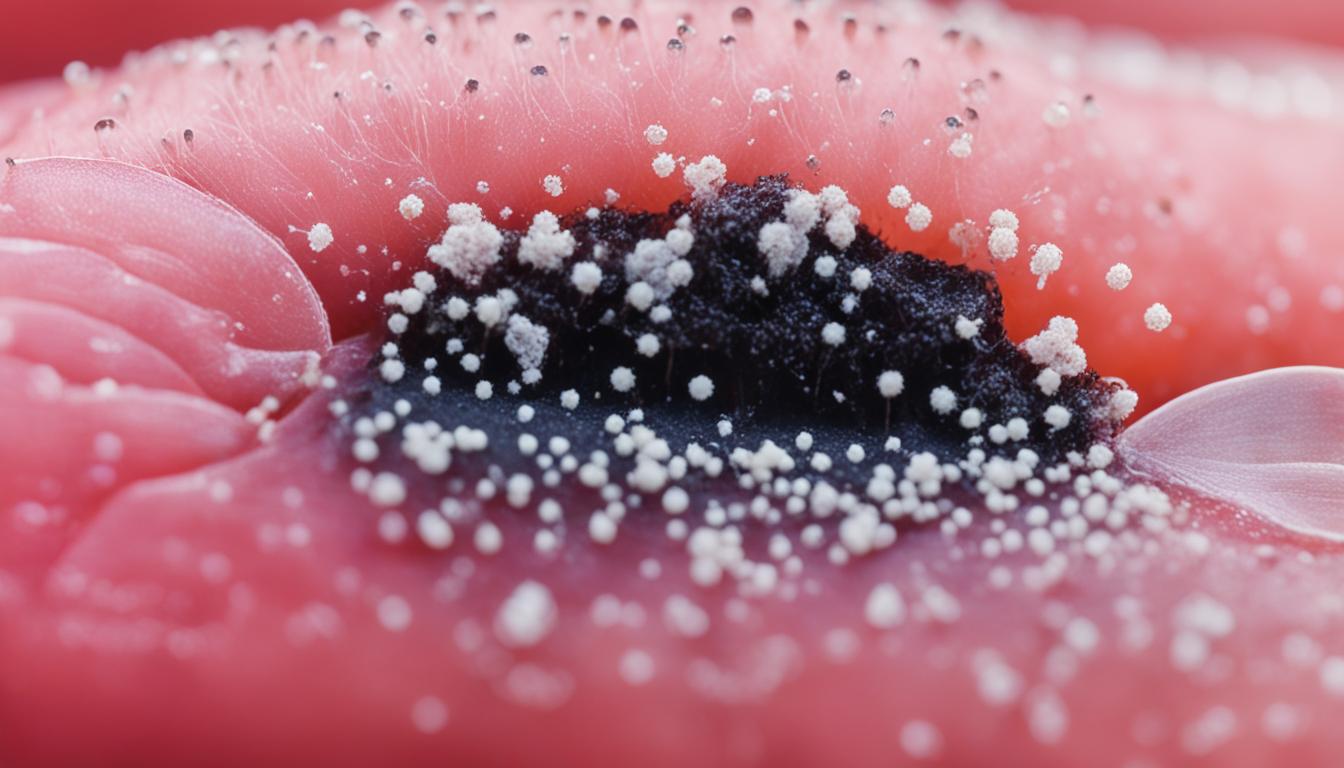
Toenail Mold Florida: Prevention & Treatment Options
In Florida’s humid climate, toenail mold can be a common problem, affecting both residents and visitors. The warm and moist conditions create an ideal environment for fungal growth, making it crucial to take preventive measures and seek timely treatment.
In this section, we will explore effective prevention strategies and treatment options for toenail mold in Florida. By understanding the nature of the problem and implementing necessary precautions, you can keep your toenails healthy and fungus-free.
Key Takeaways:
- Florida’s humid climate increases the risk of toenail mold.
- Proper hygiene practices and footwear choices can prevent fungal infections.
- Maintaining a clean and dry environment discourages the growth of mold.
- Over-the-counter remedies, prescription medications, and home remedies are available for treatment.
- Consulting with a medical professional is essential for accurate diagnosis and personalized treatment plans.
Understanding Toenail Mold in Florida
To effectively prevent and treat toenail mold in Florida, it is important to understand the nature of the problem. In this section, we will delve into the causes and symptoms of toenail mold, explore why Florida’s climate is particularly conducive to fungal growth, and highlight the risk factors that put individuals at a higher risk of developing toenail mold in this region.
Causes and Symptoms of Toenail Mold
Toenail mold, also known as onychomycosis, is a fungal infection that affects the nails. It is usually caused by dermatophytes, which are a type of fungi that thrive in warm and moist environments. When these fungi enter the nails, they can cause discoloration, thickening, and brittle nails. Common symptoms of toenail mold include yellowing or darkening of the nails, a foul odor, and crumbling or flaking nails.
Florida’s Climate and Fungal Growth
Florida’s warm and humid climate provides the perfect conditions for fungal growth, including toenail mold. The high humidity levels combined with frequent rainfall create an environment where fungi can thrive. Additionally, the warm temperatures in Florida allow fungi to multiply and spread rapidly. As a result, individuals living in the state are more susceptible to developing toenail mold compared to those in drier climates.
Risk Factors for Toenail Mold in Florida
While anyone can develop toenail mold, certain factors can increase the risk, particularly in a Florida climate. These risk factors include:
- Prolonged exposure to wet and damp environments, such as swimming pools, locker rooms, and communal showers.
- Wearing tight-fitting shoes or non-breathable footwear, which can create a damp environment ideal for fungal growth.
- Having a weakened immune system due to certain medical conditions or medications.
- Having a family history of toenail mold or other fungal infections.
It’s important to be aware of these risk factors and take necessary precautions to minimize the chances of developing toenail mold.

Prevention Strategies for Toenail Mold in Florida
Toenail mold prevention is crucial in maintaining healthy nails in Florida’s humid climate. By implementing practical strategies and adopting healthy habits, you can minimize the risk of toenail mold and keep your nails fungus-free. In this section, we will explore various prevention strategies and provide expert advice to help you protect your nails.
Proper Hygiene Practices
Good hygiene is the first line of defense against toenail mold. Follow these practices to maintain healthy nails:
- Regularly wash and thoroughly dry your feet, paying special attention to the areas between the toes.
- Use antifungal soap or medicated cleansers specifically designed for toenail mold prevention.
- Avoid sharing towels, socks, or shoes with others to reduce the risk of fungal transmission.
- Keep your nails trimmed and clean, ensuring no debris or moisture gets trapped under them.
Footwear Choices
The type of footwear you choose can either promote or inhibit toenail mold growth. Follow these footwear recommendations:
- Opt for shoes that allow proper ventilation and airflow, such as open-toed sandals or breathable sneakers.
- Avoid tight-fitting shoes that can cause excessive sweating and moisture buildup.
- Consider wearing moisture-wicking socks to keep your feet dry and minimize fungal growth.
- Rotate your shoes and allow them to completely dry out before wearing them again.
Maintaining a Clean and Dry Environment
A clean and dry environment is essential to discourage the growth of toenail mold. Follow these tips:
- Regularly clean and disinfect your shower or bath area to prevent fungal spores from accumulating.
- Avoid prolonged exposure to wet or damp surfaces, especially in public areas like swimming pools and locker rooms.
- Consider using antifungal sprays or powders on your feet and inside your shoes to create an inhospitable environment for fungal growth.
- Ensure proper ventilation in your living spaces to reduce humidity levels and prevent moisture buildup.
By implementing these prevention strategies, you can significantly reduce the risk of toenail mold in Florida. However, if you suspect a toenail mold infection or need further assistance, it is always recommended to consult a healthcare professional for an accurate diagnosis and personalized treatment plan.

| Prevention Strategies | Effectiveness |
|---|---|
| Proper hygiene practices | Highly effective in preventing toenail mold |
| Footwear choices | Significantly reduces the risk of fungal growth |
| Maintaining a clean and dry environment | Efficient in discouraging toenail mold |
Treatment Options for Toenail Mold in Florida
If you have already developed toenail mold in Florida, it is essential to seek treatment promptly. In this section, we will explore various options available to combat toenail mold effectively. We will discuss over-the-counter remedies, prescription medications, and home remedies that have shown efficacy in treating the infection.
1. Over-the-Counter Remedies:
There are several antifungal creams, ointments, and sprays available over the counter that can help treat toenail mold. These products usually contain active ingredients like clotrimazole or miconazole, which work by interrupting the growth of fungus.
2. Prescription Medications:
In more severe cases, dermatologists or podiatrists may prescribe oral antifungal medications. These medications, such as terbinafine or itraconazole, are taken over a prescribed period to eliminate the fungal infection. Topical prescription treatments like ciclopirox may also be recommended for localized infections.
3. Home Remedies:
For those looking for natural or alternative treatments, there are various home remedies that can be effective in combating toenail mold. Tea tree oil, apple cider vinegar, and hydrogen peroxide are commonly used remedies. However, it’s important to note that not all home remedies have strong scientific evidence supporting their effectiveness.
Note: It’s recommended to consult with a healthcare professional or dermatologist before attempting home remedies to ensure safety and efficacy.
4. Seeking Professional Help:
If you have severe symptoms, persistent infections, or if the toenail mold doesn’t respond to self-treatment, it is crucial to seek professional help. A dermatologist or podiatrist can provide a proper diagnosis and recommend appropriate treatment options tailored to your specific condition.
When to Consult a Medical Professional
If you experience any of the following, it is advisable to consult with a medical professional:
- Severe pain or discomfort
- Spread of the infection to other nails or areas
- Presence of pus or drainage
- No improvement after using over-the-counter treatments
Remember, early intervention and appropriate treatment are crucial in effectively treating toenail mold in Florida. Consulting a healthcare professional will ensure that you receive appropriate guidance and care to eliminate the infection and restore the health of your toenails.
Conclusion
In conclusion, Florida’s humid climate poses unique challenges when it comes to toenail mold. By understanding the causes and symptoms of toenail mold, implementing preventive strategies, and seeking appropriate treatment, you can maintain healthy nails and minimize the risk of fungal infections.
Prevention is key in combating toenail mold in Florida. Practicing good hygiene, such as keeping your feet clean and dry, wearing breathable footwear, and regularly changing socks can go a long way in preventing fungal growth. Additionally, maintaining a clean and dry environment, especially in areas prone to moisture, can help discourage the growth of mold.
If you suspect a toenail mold infection, it is crucial to consult with a medical professional for an accurate diagnosis and personalized treatment plan. Over-the-counter remedies, prescription medications, and home remedies can be effective in treating toenail mold. However, for more severe cases, it is advisable to seek the expertise of a podiatrist or dermatologist.
By taking proactive measures and seeking timely treatment, you can protect yourself from the discomfort and cosmetic issues associated with toenail mold in Florida. Remember, prevention is always better than cure when it comes to maintaining healthy nails in this challenging climate.




